Analysis of Stewardship and Governance Models in Organizations
VerifiedAdded on 2023/01/17
|9
|2197
|56
Report
AI Summary
This report provides a detailed analysis of stewardship and governance, focusing on the Wilson and Block models. It begins by introducing the two models and their contrasting perspectives on leadership and organizational management, with Wilson emphasizing stewardship leadership from a non-profit and biblical worldview, while Block emphasizes power distribution. The report then uses a car-toy company as a case study to illustrate the practical implications of these models, addressing key issues such as replacing leadership with stewardship, choosing partners, empowerment, service, and adventure over safety. It explores the requirements for partnership, the benefits of empowerment, and the importance of prioritizing service. The report concludes by highlighting the benefits of the stewardship model, including quality improvement, increased service, stakeholder participation, and consumer adoption, while also acknowledging potential challenges such as resistance to change and the need for accountability. The report draws on various academic sources to support its analysis and provide a comprehensive understanding of stewardship and governance in organizational contexts.
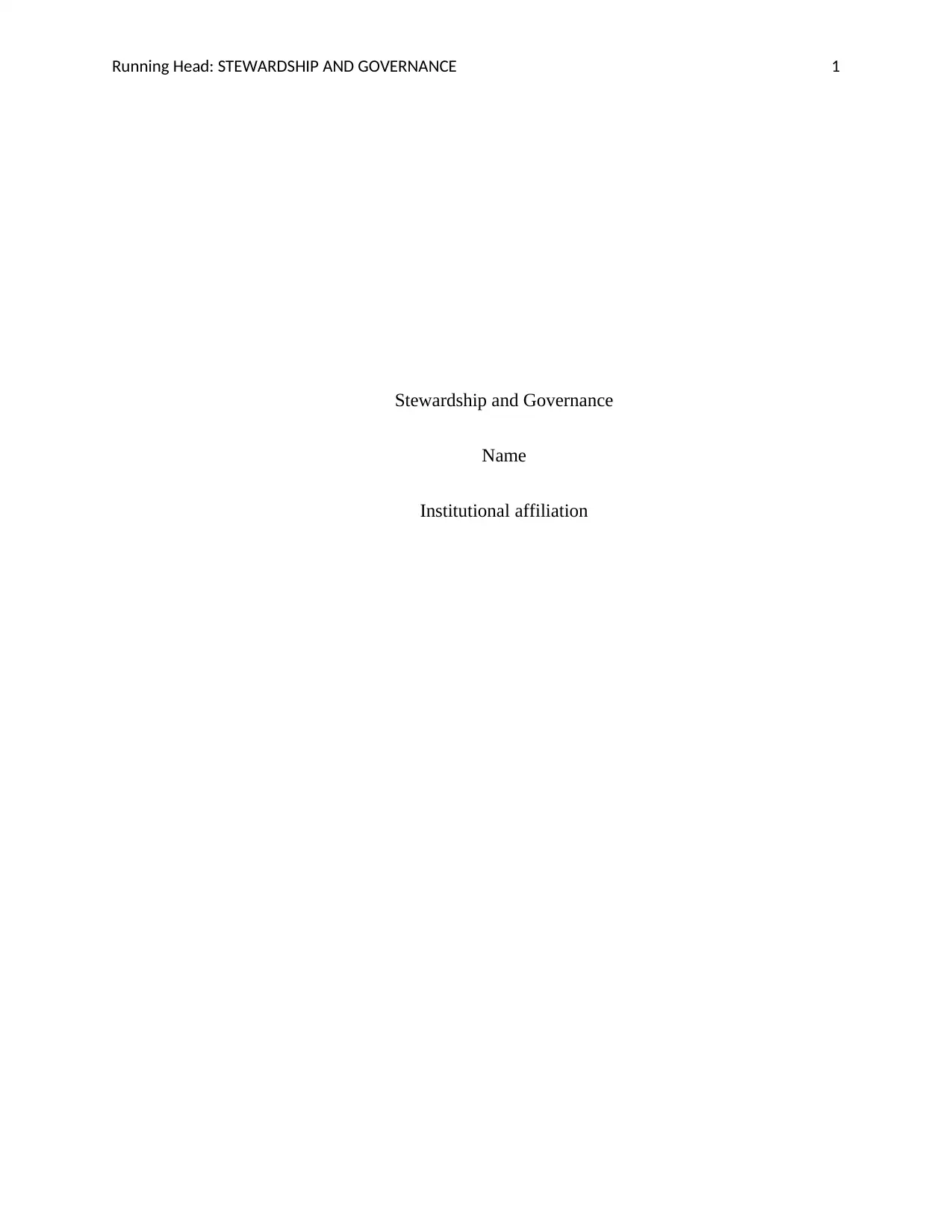
Running Head: STEWARDSHIP AND GOVERNANCE 1
Stewardship and Governance
Name
Institutional affiliation
Stewardship and Governance
Name
Institutional affiliation
Paraphrase This Document
Need a fresh take? Get an instant paraphrase of this document with our AI Paraphraser
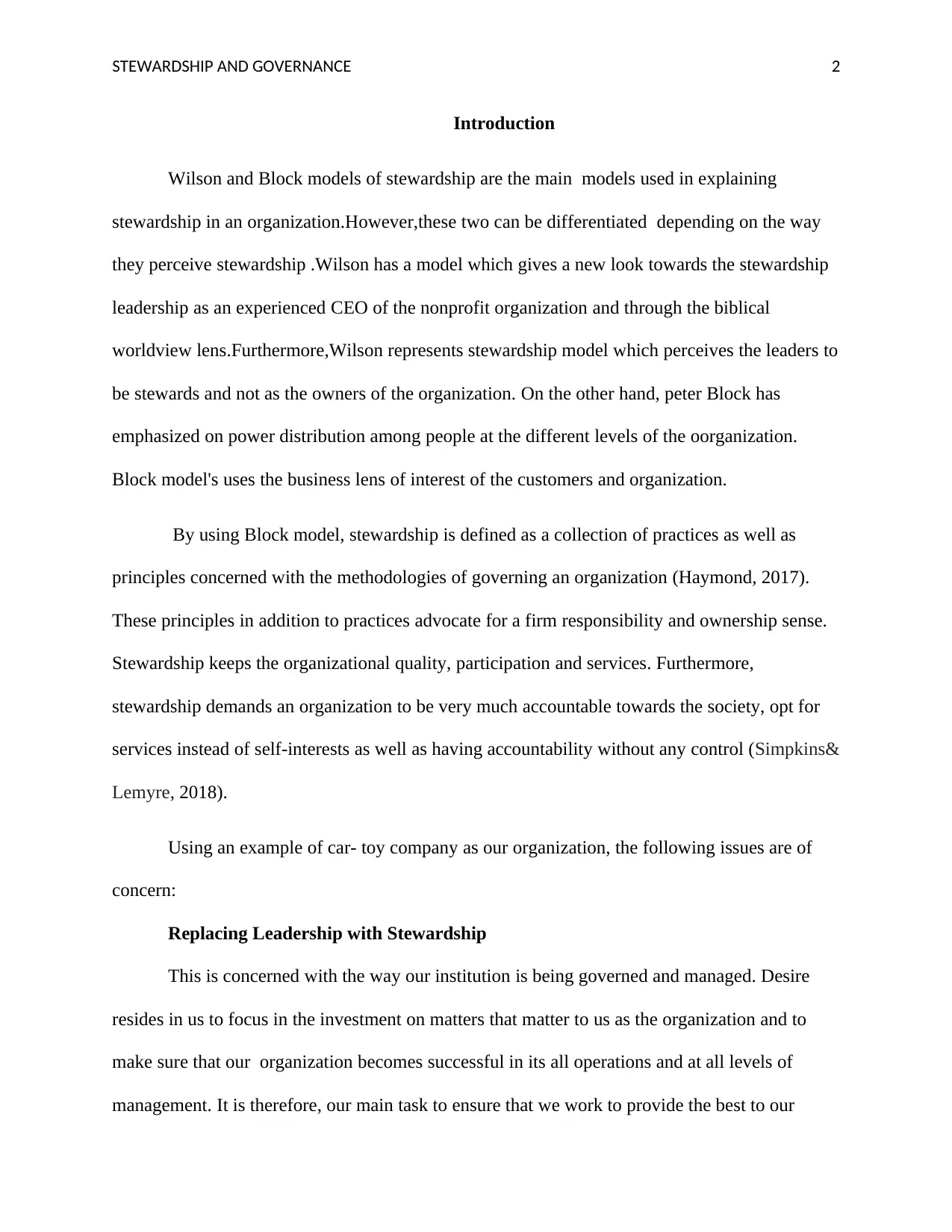
STEWARDSHIP AND GOVERNANCE 2
Introduction
Wilson and Block models of stewardship are the main models used in explaining
stewardship in an organization.However,these two can be differentiated depending on the way
they perceive stewardship .Wilson has a model which gives a new look towards the stewardship
leadership as an experienced CEO of the nonprofit organization and through the biblical
worldview lens.Furthermore,Wilson represents stewardship model which perceives the leaders to
be stewards and not as the owners of the organization. On the other hand, peter Block has
emphasized on power distribution among people at the different levels of the oorganization.
Block model's uses the business lens of interest of the customers and organization.
By using Block model, stewardship is defined as a collection of practices as well as
principles concerned with the methodologies of governing an organization (Haymond, 2017).
These principles in addition to practices advocate for a firm responsibility and ownership sense.
Stewardship keeps the organizational quality, participation and services. Furthermore,
stewardship demands an organization to be very much accountable towards the society, opt for
services instead of self-interests as well as having accountability without any control (Simpkins&
Lemyre, 2018).
Using an example of car- toy company as our organization, the following issues are of
concern:
Replacing Leadership with Stewardship
This is concerned with the way our institution is being governed and managed. Desire
resides in us to focus in the investment on matters that matter to us as the organization and to
make sure that our organization becomes successful in its all operations and at all levels of
management. It is therefore, our main task to ensure that we work to provide the best to our
Introduction
Wilson and Block models of stewardship are the main models used in explaining
stewardship in an organization.However,these two can be differentiated depending on the way
they perceive stewardship .Wilson has a model which gives a new look towards the stewardship
leadership as an experienced CEO of the nonprofit organization and through the biblical
worldview lens.Furthermore,Wilson represents stewardship model which perceives the leaders to
be stewards and not as the owners of the organization. On the other hand, peter Block has
emphasized on power distribution among people at the different levels of the oorganization.
Block model's uses the business lens of interest of the customers and organization.
By using Block model, stewardship is defined as a collection of practices as well as
principles concerned with the methodologies of governing an organization (Haymond, 2017).
These principles in addition to practices advocate for a firm responsibility and ownership sense.
Stewardship keeps the organizational quality, participation and services. Furthermore,
stewardship demands an organization to be very much accountable towards the society, opt for
services instead of self-interests as well as having accountability without any control (Simpkins&
Lemyre, 2018).
Using an example of car- toy company as our organization, the following issues are of
concern:
Replacing Leadership with Stewardship
This is concerned with the way our institution is being governed and managed. Desire
resides in us to focus in the investment on matters that matter to us as the organization and to
make sure that our organization becomes successful in its all operations and at all levels of
management. It is therefore, our main task to ensure that we work to provide the best to our
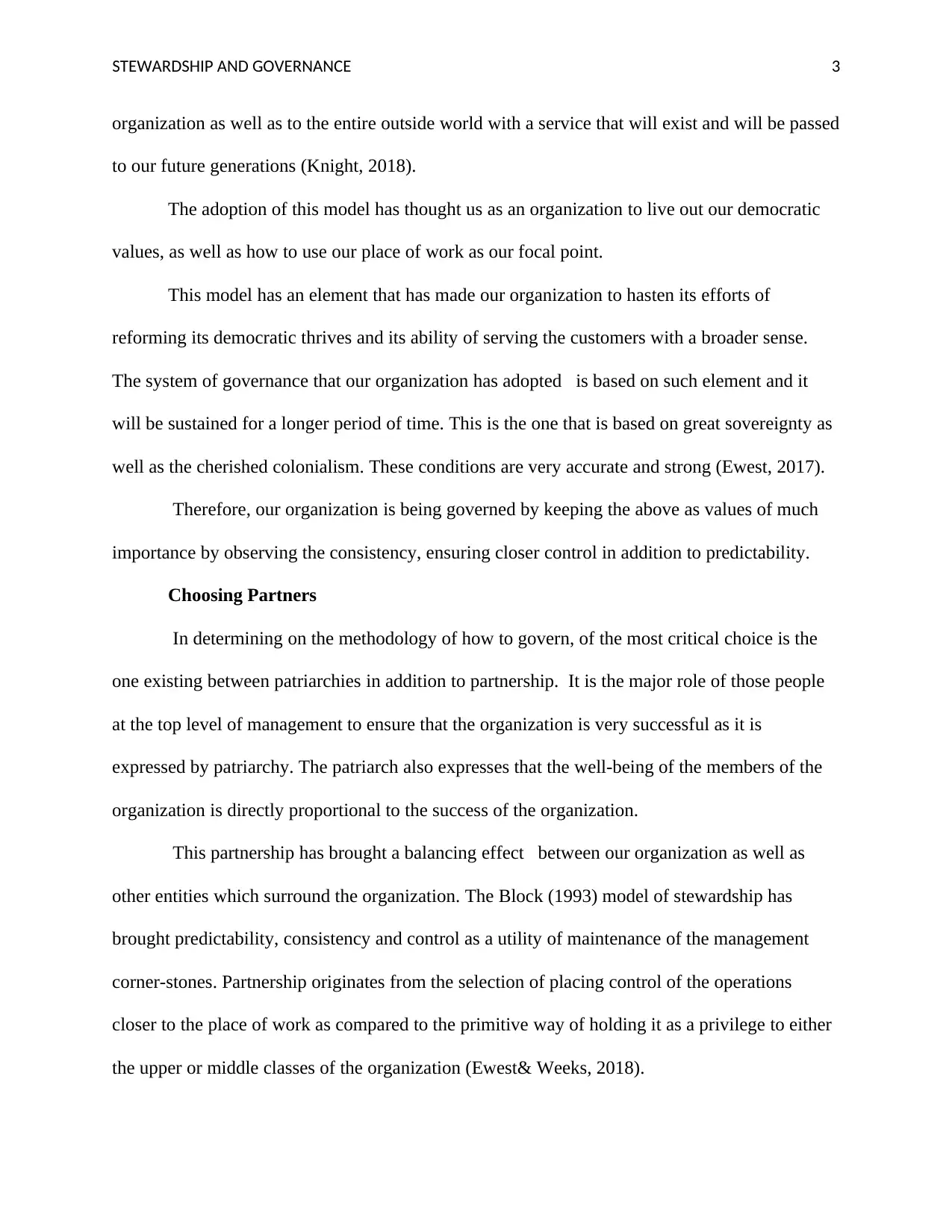
STEWARDSHIP AND GOVERNANCE 3
organization as well as to the entire outside world with a service that will exist and will be passed
to our future generations (Knight, 2018).
The adoption of this model has thought us as an organization to live out our democratic
values, as well as how to use our place of work as our focal point.
This model has an element that has made our organization to hasten its efforts of
reforming its democratic thrives and its ability of serving the customers with a broader sense.
The system of governance that our organization has adopted is based on such element and it
will be sustained for a longer period of time. This is the one that is based on great sovereignty as
well as the cherished colonialism. These conditions are very accurate and strong (Ewest, 2017).
Therefore, our organization is being governed by keeping the above as values of much
importance by observing the consistency, ensuring closer control in addition to predictability.
Choosing Partners
In determining on the methodology of how to govern, of the most critical choice is the
one existing between patriarchies in addition to partnership. It is the major role of those people
at the top level of management to ensure that the organization is very successful as it is
expressed by patriarchy. The patriarch also expresses that the well-being of the members of the
organization is directly proportional to the success of the organization.
This partnership has brought a balancing effect between our organization as well as
other entities which surround the organization. The Block (1993) model of stewardship has
brought predictability, consistency and control as a utility of maintenance of the management
corner-stones. Partnership originates from the selection of placing control of the operations
closer to the place of work as compared to the primitive way of holding it as a privilege to either
the upper or middle classes of the organization (Ewest& Weeks, 2018).
organization as well as to the entire outside world with a service that will exist and will be passed
to our future generations (Knight, 2018).
The adoption of this model has thought us as an organization to live out our democratic
values, as well as how to use our place of work as our focal point.
This model has an element that has made our organization to hasten its efforts of
reforming its democratic thrives and its ability of serving the customers with a broader sense.
The system of governance that our organization has adopted is based on such element and it
will be sustained for a longer period of time. This is the one that is based on great sovereignty as
well as the cherished colonialism. These conditions are very accurate and strong (Ewest, 2017).
Therefore, our organization is being governed by keeping the above as values of much
importance by observing the consistency, ensuring closer control in addition to predictability.
Choosing Partners
In determining on the methodology of how to govern, of the most critical choice is the
one existing between patriarchies in addition to partnership. It is the major role of those people
at the top level of management to ensure that the organization is very successful as it is
expressed by patriarchy. The patriarch also expresses that the well-being of the members of the
organization is directly proportional to the success of the organization.
This partnership has brought a balancing effect between our organization as well as
other entities which surround the organization. The Block (1993) model of stewardship has
brought predictability, consistency and control as a utility of maintenance of the management
corner-stones. Partnership originates from the selection of placing control of the operations
closer to the place of work as compared to the primitive way of holding it as a privilege to either
the upper or middle classes of the organization (Ewest& Weeks, 2018).
⊘ This is a preview!⊘
Do you want full access?
Subscribe today to unlock all pages.

Trusted by 1+ million students worldwide
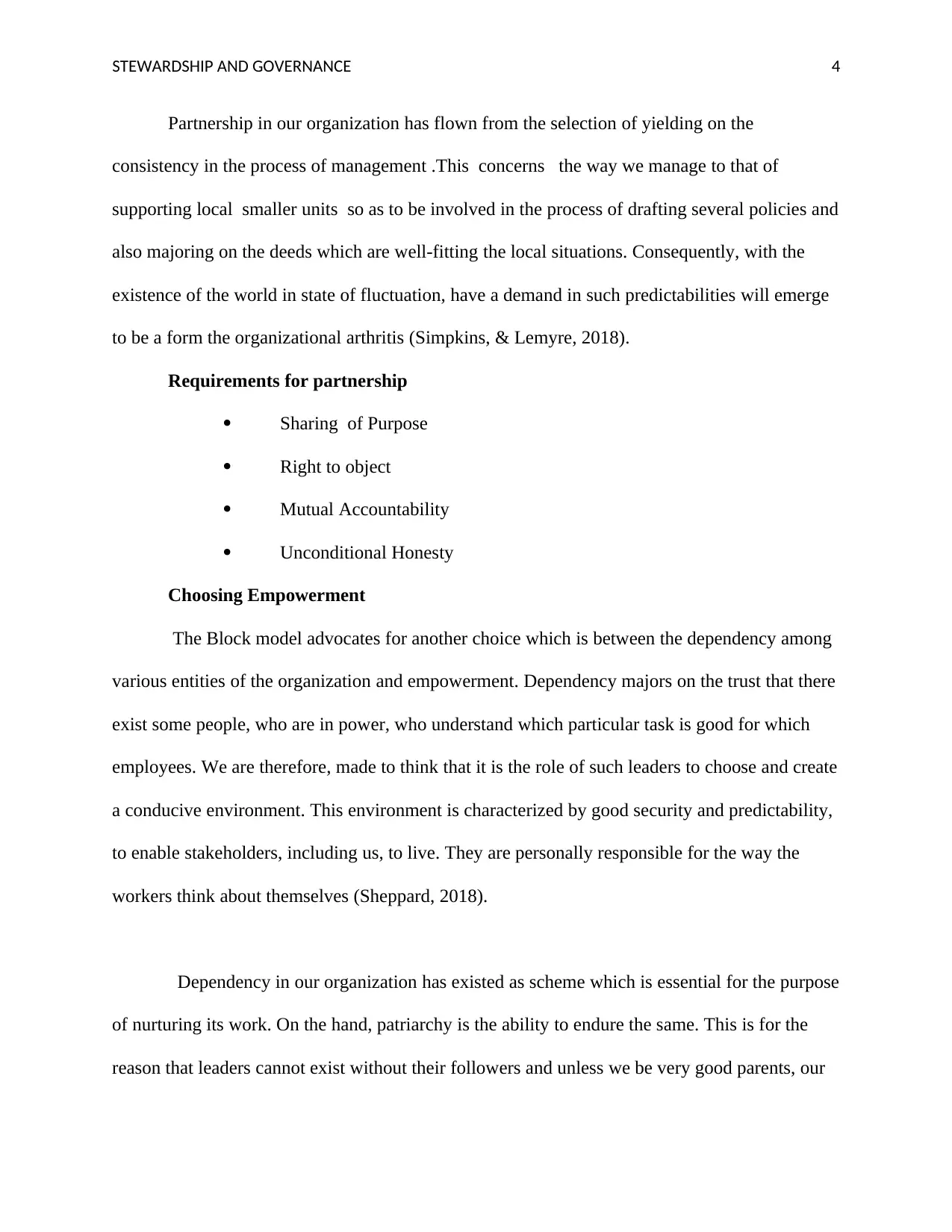
STEWARDSHIP AND GOVERNANCE 4
Partnership in our organization has flown from the selection of yielding on the
consistency in the process of management .This concerns the way we manage to that of
supporting local smaller units so as to be involved in the process of drafting several policies and
also majoring on the deeds which are well-fitting the local situations. Consequently, with the
existence of the world in state of fluctuation, have a demand in such predictabilities will emerge
to be a form the organizational arthritis (Simpkins, & Lemyre, 2018).
Requirements for partnership
Sharing of Purpose
Right to object
Mutual Accountability
Unconditional Honesty
Choosing Empowerment
The Block model advocates for another choice which is between the dependency among
various entities of the organization and empowerment. Dependency majors on the trust that there
exist some people, who are in power, who understand which particular task is good for which
employees. We are therefore, made to think that it is the role of such leaders to choose and create
a conducive environment. This environment is characterized by good security and predictability,
to enable stakeholders, including us, to live. They are personally responsible for the way the
workers think about themselves (Sheppard, 2018).
Dependency in our organization has existed as scheme which is essential for the purpose
of nurturing its work. On the hand, patriarchy is the ability to endure the same. This is for the
reason that leaders cannot exist without their followers and unless we be very good parents, our
Partnership in our organization has flown from the selection of yielding on the
consistency in the process of management .This concerns the way we manage to that of
supporting local smaller units so as to be involved in the process of drafting several policies and
also majoring on the deeds which are well-fitting the local situations. Consequently, with the
existence of the world in state of fluctuation, have a demand in such predictabilities will emerge
to be a form the organizational arthritis (Simpkins, & Lemyre, 2018).
Requirements for partnership
Sharing of Purpose
Right to object
Mutual Accountability
Unconditional Honesty
Choosing Empowerment
The Block model advocates for another choice which is between the dependency among
various entities of the organization and empowerment. Dependency majors on the trust that there
exist some people, who are in power, who understand which particular task is good for which
employees. We are therefore, made to think that it is the role of such leaders to choose and create
a conducive environment. This environment is characterized by good security and predictability,
to enable stakeholders, including us, to live. They are personally responsible for the way the
workers think about themselves (Sheppard, 2018).
Dependency in our organization has existed as scheme which is essential for the purpose
of nurturing its work. On the hand, patriarchy is the ability to endure the same. This is for the
reason that leaders cannot exist without their followers and unless we be very good parents, our
Paraphrase This Document
Need a fresh take? Get an instant paraphrase of this document with our AI Paraphraser
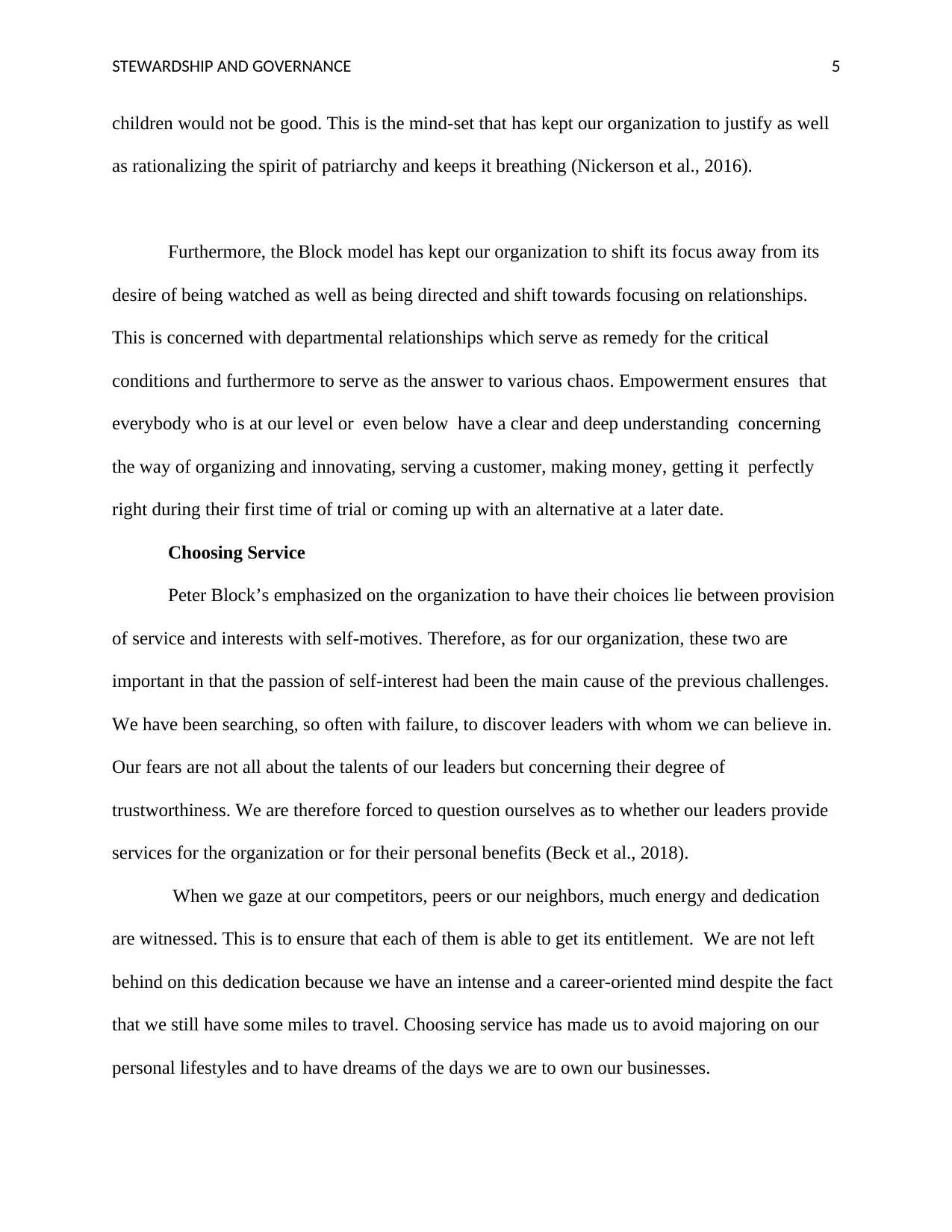
STEWARDSHIP AND GOVERNANCE 5
children would not be good. This is the mind-set that has kept our organization to justify as well
as rationalizing the spirit of patriarchy and keeps it breathing (Nickerson et al., 2016).
Furthermore, the Block model has kept our organization to shift its focus away from its
desire of being watched as well as being directed and shift towards focusing on relationships.
This is concerned with departmental relationships which serve as remedy for the critical
conditions and furthermore to serve as the answer to various chaos. Empowerment ensures that
everybody who is at our level or even below have a clear and deep understanding concerning
the way of organizing and innovating, serving a customer, making money, getting it perfectly
right during their first time of trial or coming up with an alternative at a later date.
Choosing Service
Peter Block’s emphasized on the organization to have their choices lie between provision
of service and interests with self-motives. Therefore, as for our organization, these two are
important in that the passion of self-interest had been the main cause of the previous challenges.
We have been searching, so often with failure, to discover leaders with whom we can believe in.
Our fears are not all about the talents of our leaders but concerning their degree of
trustworthiness. We are therefore forced to question ourselves as to whether our leaders provide
services for the organization or for their personal benefits (Beck et al., 2018).
When we gaze at our competitors, peers or our neighbors, much energy and dedication
are witnessed. This is to ensure that each of them is able to get its entitlement. We are not left
behind on this dedication because we have an intense and a career-oriented mind despite the fact
that we still have some miles to travel. Choosing service has made us to avoid majoring on our
personal lifestyles and to have dreams of the days we are to own our businesses.
children would not be good. This is the mind-set that has kept our organization to justify as well
as rationalizing the spirit of patriarchy and keeps it breathing (Nickerson et al., 2016).
Furthermore, the Block model has kept our organization to shift its focus away from its
desire of being watched as well as being directed and shift towards focusing on relationships.
This is concerned with departmental relationships which serve as remedy for the critical
conditions and furthermore to serve as the answer to various chaos. Empowerment ensures that
everybody who is at our level or even below have a clear and deep understanding concerning
the way of organizing and innovating, serving a customer, making money, getting it perfectly
right during their first time of trial or coming up with an alternative at a later date.
Choosing Service
Peter Block’s emphasized on the organization to have their choices lie between provision
of service and interests with self-motives. Therefore, as for our organization, these two are
important in that the passion of self-interest had been the main cause of the previous challenges.
We have been searching, so often with failure, to discover leaders with whom we can believe in.
Our fears are not all about the talents of our leaders but concerning their degree of
trustworthiness. We are therefore forced to question ourselves as to whether our leaders provide
services for the organization or for their personal benefits (Beck et al., 2018).
When we gaze at our competitors, peers or our neighbors, much energy and dedication
are witnessed. This is to ensure that each of them is able to get its entitlement. We are not left
behind on this dedication because we have an intense and a career-oriented mind despite the fact
that we still have some miles to travel. Choosing service has made us to avoid majoring on our
personal lifestyles and to have dreams of the days we are to own our businesses.
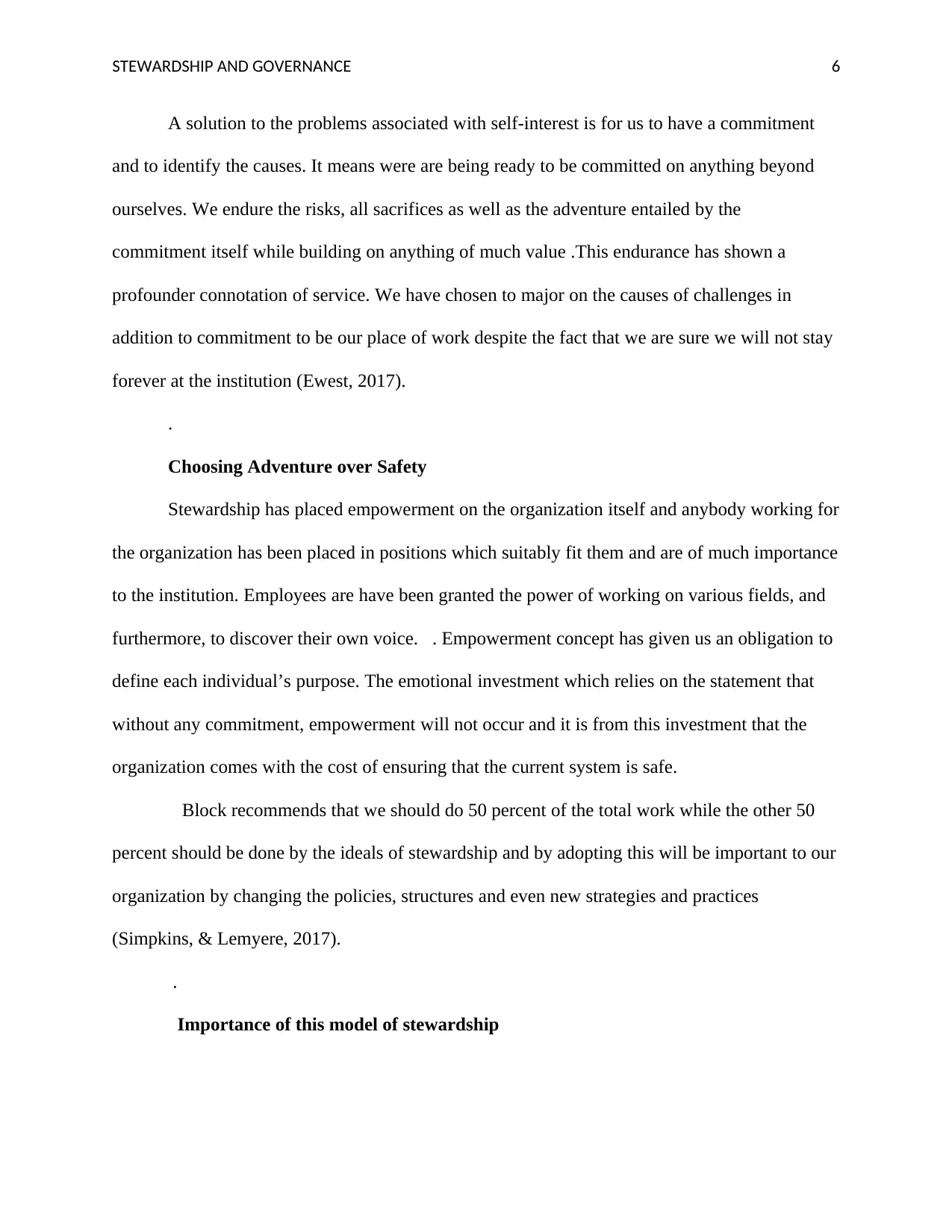
STEWARDSHIP AND GOVERNANCE 6
A solution to the problems associated with self-interest is for us to have a commitment
and to identify the causes. It means were are being ready to be committed on anything beyond
ourselves. We endure the risks, all sacrifices as well as the adventure entailed by the
commitment itself while building on anything of much value .This endurance has shown a
profounder connotation of service. We have chosen to major on the causes of challenges in
addition to commitment to be our place of work despite the fact that we are sure we will not stay
forever at the institution (Ewest, 2017).
.
Choosing Adventure over Safety
Stewardship has placed empowerment on the organization itself and anybody working for
the organization has been placed in positions which suitably fit them and are of much importance
to the institution. Employees are have been granted the power of working on various fields, and
furthermore, to discover their own voice. . Empowerment concept has given us an obligation to
define each individual’s purpose. The emotional investment which relies on the statement that
without any commitment, empowerment will not occur and it is from this investment that the
organization comes with the cost of ensuring that the current system is safe.
Block recommends that we should do 50 percent of the total work while the other 50
percent should be done by the ideals of stewardship and by adopting this will be important to our
organization by changing the policies, structures and even new strategies and practices
(Simpkins, & Lemyere, 2017).
.
Importance of this model of stewardship
A solution to the problems associated with self-interest is for us to have a commitment
and to identify the causes. It means were are being ready to be committed on anything beyond
ourselves. We endure the risks, all sacrifices as well as the adventure entailed by the
commitment itself while building on anything of much value .This endurance has shown a
profounder connotation of service. We have chosen to major on the causes of challenges in
addition to commitment to be our place of work despite the fact that we are sure we will not stay
forever at the institution (Ewest, 2017).
.
Choosing Adventure over Safety
Stewardship has placed empowerment on the organization itself and anybody working for
the organization has been placed in positions which suitably fit them and are of much importance
to the institution. Employees are have been granted the power of working on various fields, and
furthermore, to discover their own voice. . Empowerment concept has given us an obligation to
define each individual’s purpose. The emotional investment which relies on the statement that
without any commitment, empowerment will not occur and it is from this investment that the
organization comes with the cost of ensuring that the current system is safe.
Block recommends that we should do 50 percent of the total work while the other 50
percent should be done by the ideals of stewardship and by adopting this will be important to our
organization by changing the policies, structures and even new strategies and practices
(Simpkins, & Lemyere, 2017).
.
Importance of this model of stewardship
⊘ This is a preview!⊘
Do you want full access?
Subscribe today to unlock all pages.

Trusted by 1+ million students worldwide
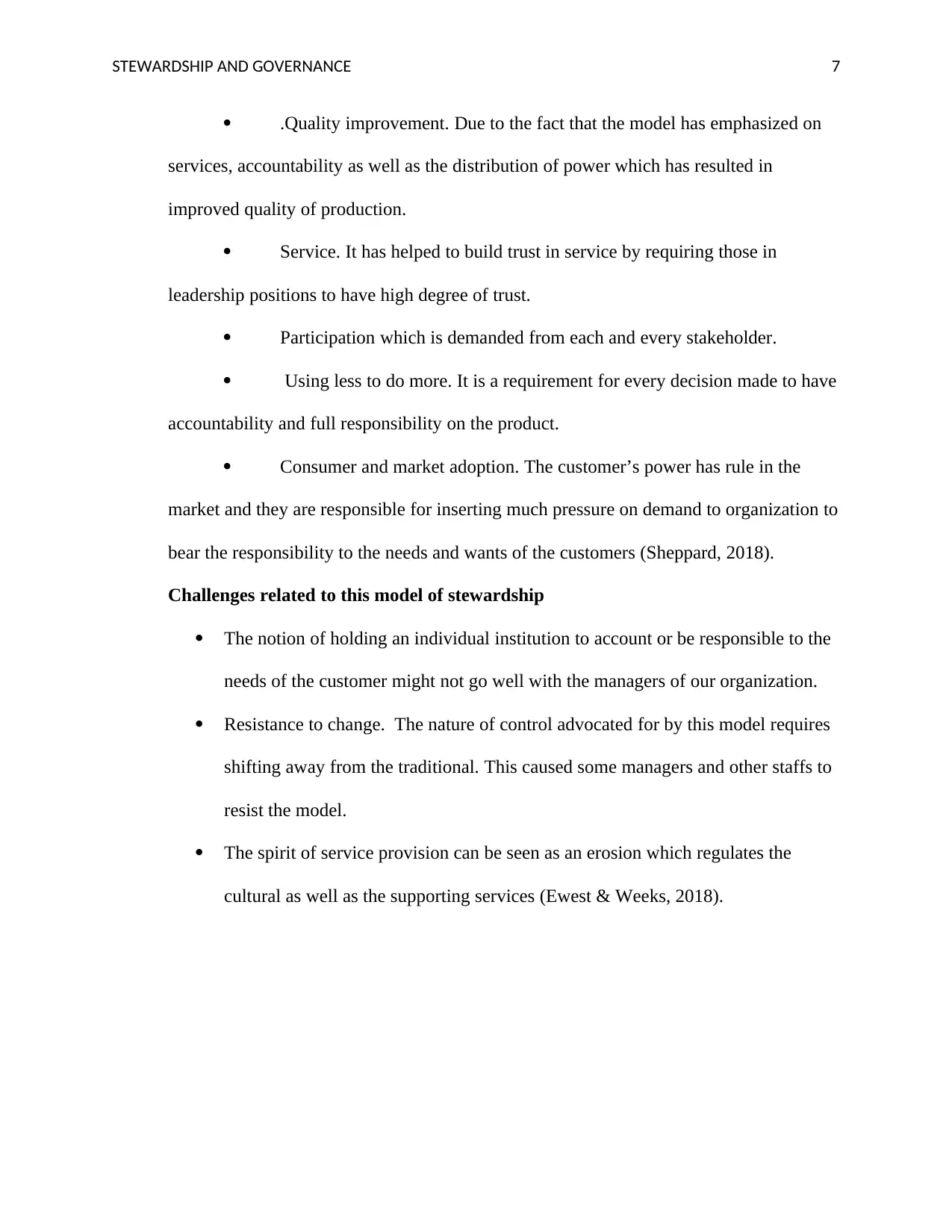
STEWARDSHIP AND GOVERNANCE 7
.Quality improvement. Due to the fact that the model has emphasized on
services, accountability as well as the distribution of power which has resulted in
improved quality of production.
Service. It has helped to build trust in service by requiring those in
leadership positions to have high degree of trust.
Participation which is demanded from each and every stakeholder.
Using less to do more. It is a requirement for every decision made to have
accountability and full responsibility on the product.
Consumer and market adoption. The customer’s power has rule in the
market and they are responsible for inserting much pressure on demand to organization to
bear the responsibility to the needs and wants of the customers (Sheppard, 2018).
Challenges related to this model of stewardship
The notion of holding an individual institution to account or be responsible to the
needs of the customer might not go well with the managers of our organization.
Resistance to change. The nature of control advocated for by this model requires
shifting away from the traditional. This caused some managers and other staffs to
resist the model.
The spirit of service provision can be seen as an erosion which regulates the
cultural as well as the supporting services (Ewest & Weeks, 2018).
.Quality improvement. Due to the fact that the model has emphasized on
services, accountability as well as the distribution of power which has resulted in
improved quality of production.
Service. It has helped to build trust in service by requiring those in
leadership positions to have high degree of trust.
Participation which is demanded from each and every stakeholder.
Using less to do more. It is a requirement for every decision made to have
accountability and full responsibility on the product.
Consumer and market adoption. The customer’s power has rule in the
market and they are responsible for inserting much pressure on demand to organization to
bear the responsibility to the needs and wants of the customers (Sheppard, 2018).
Challenges related to this model of stewardship
The notion of holding an individual institution to account or be responsible to the
needs of the customer might not go well with the managers of our organization.
Resistance to change. The nature of control advocated for by this model requires
shifting away from the traditional. This caused some managers and other staffs to
resist the model.
The spirit of service provision can be seen as an erosion which regulates the
cultural as well as the supporting services (Ewest & Weeks, 2018).
Paraphrase This Document
Need a fresh take? Get an instant paraphrase of this document with our AI Paraphraser
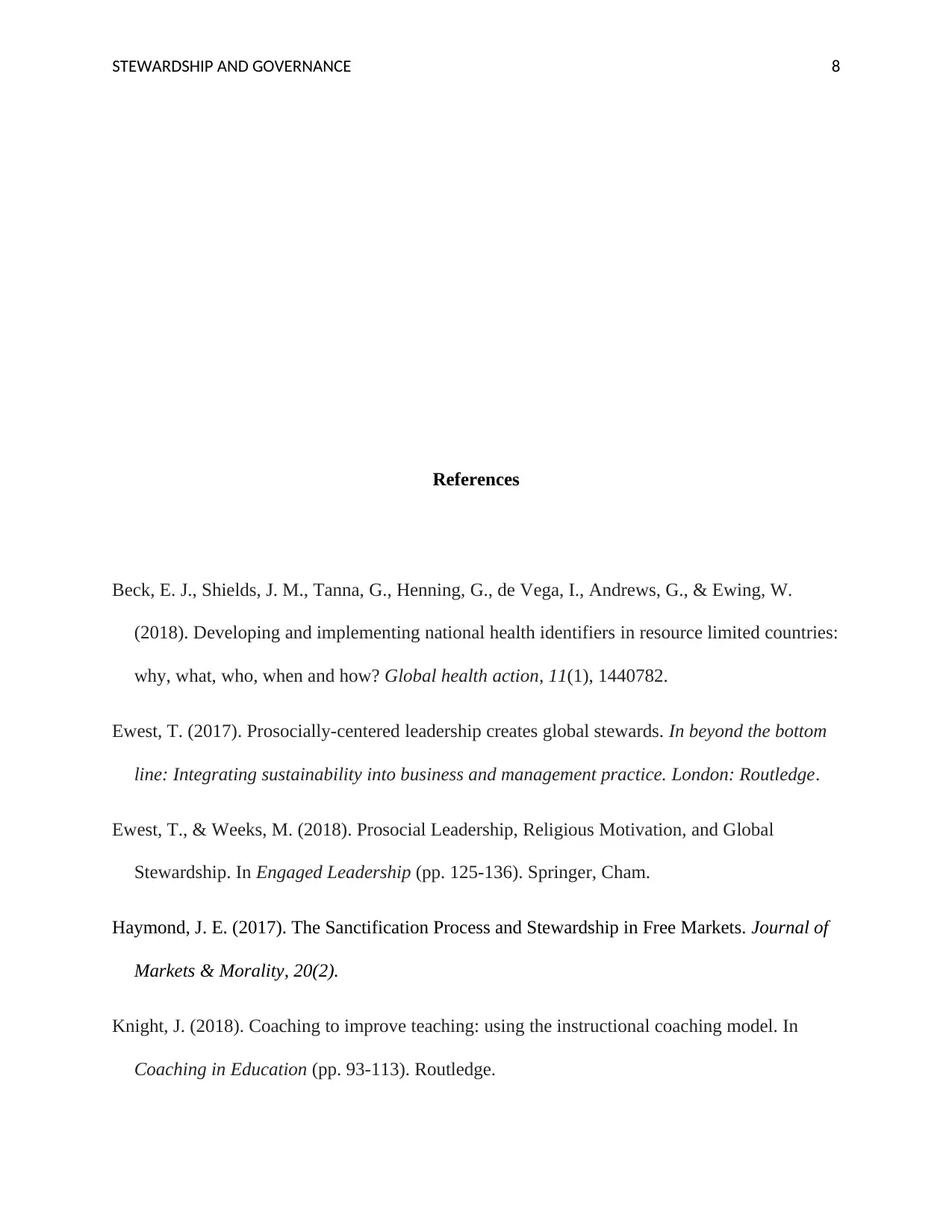
STEWARDSHIP AND GOVERNANCE 8
References
Beck, E. J., Shields, J. M., Tanna, G., Henning, G., de Vega, I., Andrews, G., & Ewing, W.
(2018). Developing and implementing national health identifiers in resource limited countries:
why, what, who, when and how? Global health action, 11(1), 1440782.
Ewest, T. (2017). Prosocially-centered leadership creates global stewards. In beyond the bottom
line: Integrating sustainability into business and management practice. London: Routledge.
Ewest, T., & Weeks, M. (2018). Prosocial Leadership, Religious Motivation, and Global
Stewardship. In Engaged Leadership (pp. 125-136). Springer, Cham.
Haymond, J. E. (2017). The Sanctification Process and Stewardship in Free Markets. Journal of
Markets & Morality, 20(2).
Knight, J. (2018). Coaching to improve teaching: using the instructional coaching model. In
Coaching in Education (pp. 93-113). Routledge.
References
Beck, E. J., Shields, J. M., Tanna, G., Henning, G., de Vega, I., Andrews, G., & Ewing, W.
(2018). Developing and implementing national health identifiers in resource limited countries:
why, what, who, when and how? Global health action, 11(1), 1440782.
Ewest, T. (2017). Prosocially-centered leadership creates global stewards. In beyond the bottom
line: Integrating sustainability into business and management practice. London: Routledge.
Ewest, T., & Weeks, M. (2018). Prosocial Leadership, Religious Motivation, and Global
Stewardship. In Engaged Leadership (pp. 125-136). Springer, Cham.
Haymond, J. E. (2017). The Sanctification Process and Stewardship in Free Markets. Journal of
Markets & Morality, 20(2).
Knight, J. (2018). Coaching to improve teaching: using the instructional coaching model. In
Coaching in Education (pp. 93-113). Routledge.
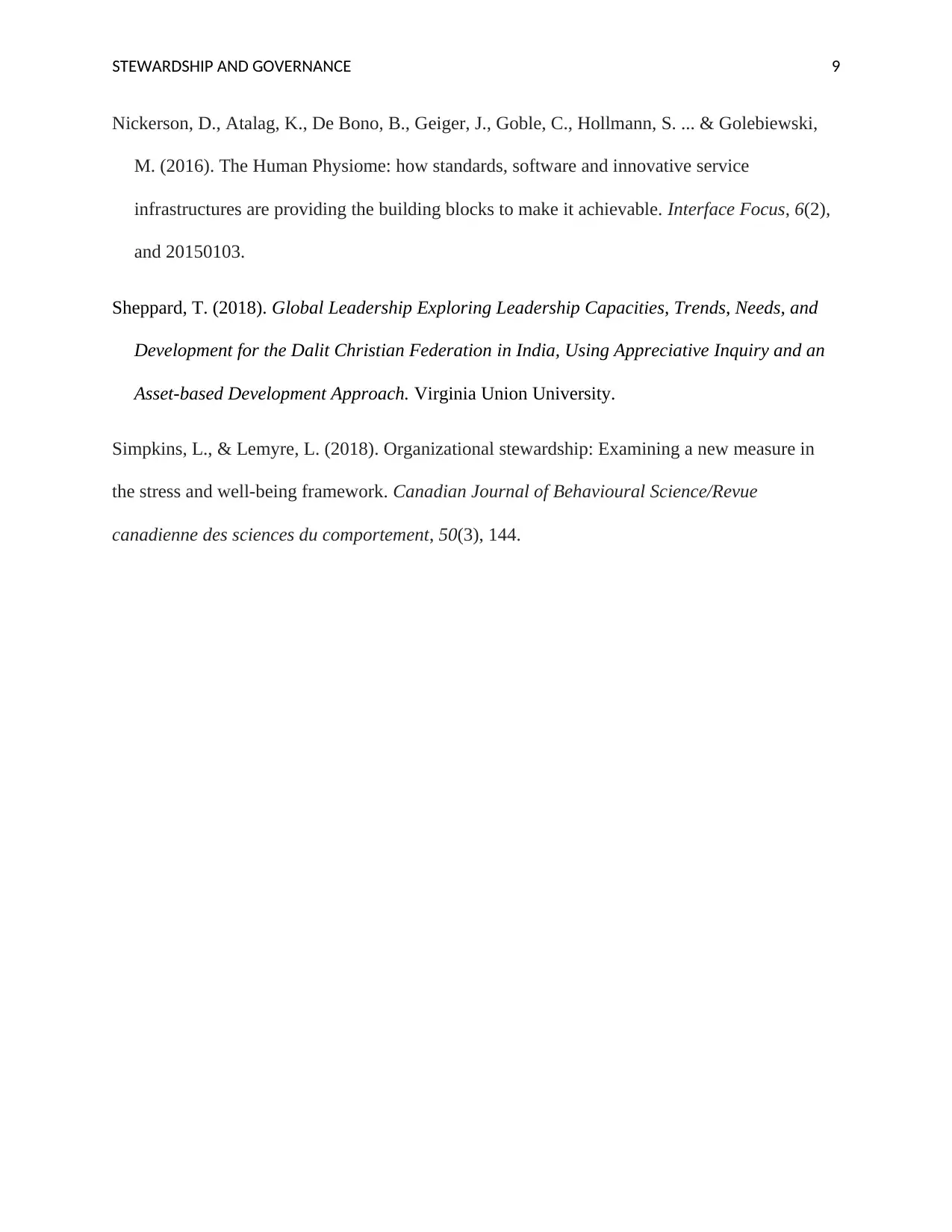
STEWARDSHIP AND GOVERNANCE 9
Nickerson, D., Atalag, K., De Bono, B., Geiger, J., Goble, C., Hollmann, S. ... & Golebiewski,
M. (2016). The Human Physiome: how standards, software and innovative service
infrastructures are providing the building blocks to make it achievable. Interface Focus, 6(2),
and 20150103.
Sheppard, T. (2018). Global Leadership Exploring Leadership Capacities, Trends, Needs, and
Development for the Dalit Christian Federation in India, Using Appreciative Inquiry and an
Asset-based Development Approach. Virginia Union University.
Simpkins, L., & Lemyre, L. (2018). Organizational stewardship: Examining a new measure in
the stress and well-being framework. Canadian Journal of Behavioural Science/Revue
canadienne des sciences du comportement, 50(3), 144.
Nickerson, D., Atalag, K., De Bono, B., Geiger, J., Goble, C., Hollmann, S. ... & Golebiewski,
M. (2016). The Human Physiome: how standards, software and innovative service
infrastructures are providing the building blocks to make it achievable. Interface Focus, 6(2),
and 20150103.
Sheppard, T. (2018). Global Leadership Exploring Leadership Capacities, Trends, Needs, and
Development for the Dalit Christian Federation in India, Using Appreciative Inquiry and an
Asset-based Development Approach. Virginia Union University.
Simpkins, L., & Lemyre, L. (2018). Organizational stewardship: Examining a new measure in
the stress and well-being framework. Canadian Journal of Behavioural Science/Revue
canadienne des sciences du comportement, 50(3), 144.
⊘ This is a preview!⊘
Do you want full access?
Subscribe today to unlock all pages.

Trusted by 1+ million students worldwide
1 out of 9
Related Documents
Your All-in-One AI-Powered Toolkit for Academic Success.
+13062052269
info@desklib.com
Available 24*7 on WhatsApp / Email
![[object Object]](/_next/static/media/star-bottom.7253800d.svg)
Unlock your academic potential
Copyright © 2020–2025 A2Z Services. All Rights Reserved. Developed and managed by ZUCOL.




